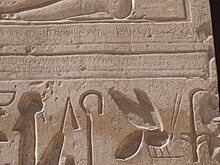| Abydos graffiti | |
|---|---|
 Phoenician graffiti (right hand side) at the Temple of Seti I | |
| Type | Graffiti |
| Writing | Phoenician and Aramaic |
| Discovered | 1855 Temple of Seti I |
| Discovered by | Théodule Devéria |
| Present location | Egypt |
| Identification | |
The Abydos graffiti is Phoenician and Aramaic graffiti found on the walls of the Temple of Seti I at Abydos, Egypt. The inscriptions are known as KAI 49, CIS I 99-110 and RÉS 1302ff.
Much of the graffiti represents prayers and votive dedications.[1]
Prior to the discovery of the Abydos graffiti, very few Semitic inscriptions had been found in Egypt – a few Aramaic texts, the Abu Simbel Phoenician graffiti (published by Ampère, Lepsius, and Graham), and an engraved sphinx found in the Serapeum of Saqqara. Abydos was considered to contain the tomb of Osiris, the god of the afterlife, hence it was considered a holy burial place and attracted pilgrimage.[2]
- ^ Naveh, J. (1979). Graffiti and Dedications. Bulletin of the American Schools of Oriental Research, (235), 27-30. doi:10.2307/1356553
- ^ Zotenberg, H., "Nouvelles inscriptions phéniciennes d'Égypte." JA sér. 6, t. 11 (1868): 431–50 + 2 pls (also at BNF, including full plate scans): "Dans le grand nombre d'inscriptions diverses qui ont été trouvées jusqu'à ce jour aux bords du Nil, les anciennes inscriptions sémitiques sont fort rares... En dehors de quelques textes araméens, les seules inscriptions phéniciennes découvertes en Égypte jusqu'à ce jour, sont celles d'Ipsambul, copiées successivement par Ampère, Lepsius, et Graham, et quatre lignes gravées sur un des sphinx du sérapéum de Memphis... Deux temples, dont l'un construit par Séti Ier l'autre par Ramsès II, lui étaient consacrés. Elle renfermait, en outre, le tombeau d'Osiris... Mais Abydos avait la prétention de posséder le vrai tombeau du dieu Osiris, et cette croyance eut pour effet que beaucoup d'Égyptiens, de toutes les parties du pays, firent établir leurs sépultures à proximité de l'endroit où reposait le dieu. Il est naturel que cette coutume ait ajouté à la sainteté du lieu et du culte d'Abydos. Aussi cette ville attira-t-elle de très-nombreux pèlerins venus de tous côtés pour y adorer Osiris.